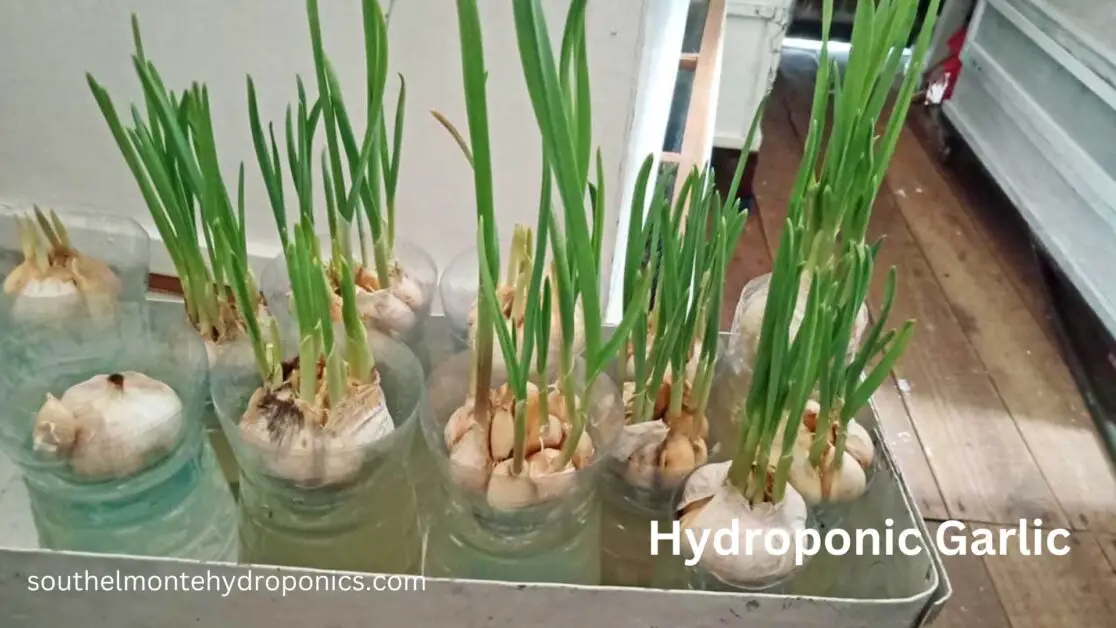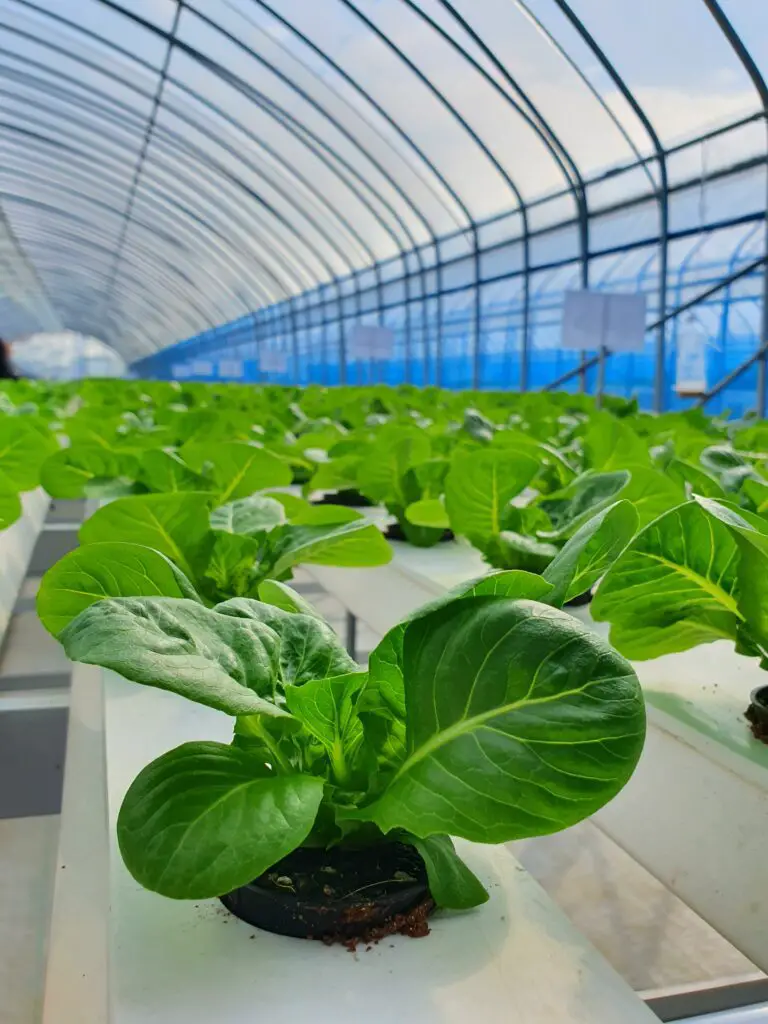Hydroponic Garlic: No. 1 to Grow the Best Flavorful and Nutritious Garlic in Water
Table of Contents
Essential Equipment for Hydroponic Garlic Production: A detailed overview of the necessary tools and materials required to set up a successful hydroponic garlic system.
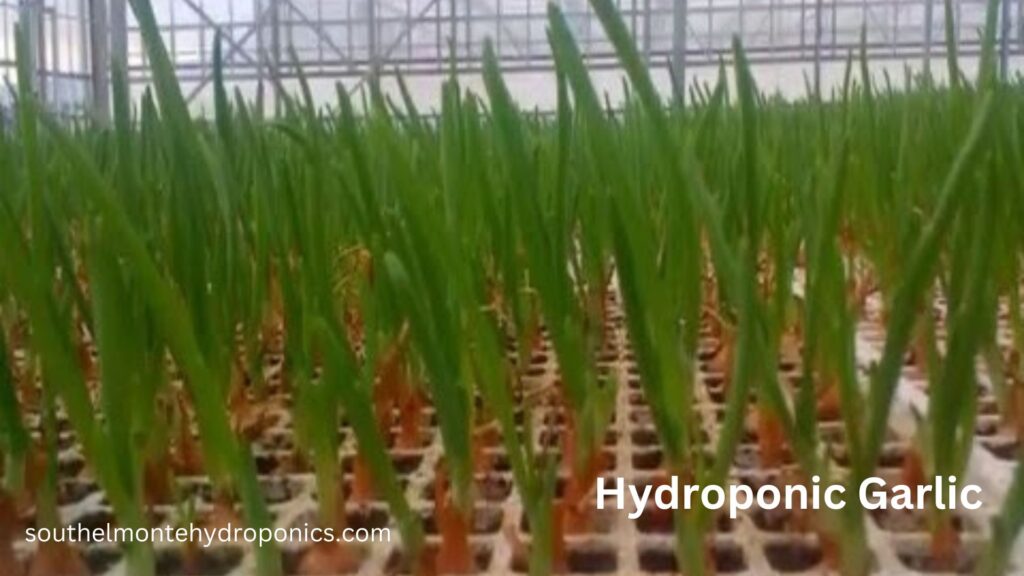
To set up a successful hydroponic garlic system, it is important to have the right tools and materials on hand. These essential equipment will ensure that your garlic plants receive the necessary support and nutrients to thrive in a soil-less environment.
One of the key tools you will need is a hydroponic system, such as a nutrient film technique (NFT) or a deep water culture (DWC) system. These systems provide a controlled environment for your garlic plants, allowing you to monitor and regulate factors such as water and nutrient levels.
In addition to the hydroponic system, you will also need a reliable source of artificial lighting. Garlic plants require sufficient light to photosynthesize and grow. High-intensity discharge (HID) lights, such as metal halide (MH) or high-pressure sodium (HPS) lights, are commonly used in hydroponics for their ability to provide the necessary light intensity.
To further support the growth of your garlic plants, you will need to have a proper nutrient solution. This solution should contain the essential macronutrients (nitrogen, phosphorus, and potassium) as well as micronutrients (iron, manganese, zinc, etc.) that garlic plants require for healthy development. You can either purchase pre-formulated nutrient solutions or create your own using water-soluble fertilizers.
Additional tools and materials that are essential for hydroponic garlic production include pH testing kits to monitor and adjust the nutrient solution’s acidity levels, growing medium such as rockwool cubes or coco coir for germinating garlic seeds, and a reliable ventilation system to maintain optimal temperature and air circulation within the growing area.
By ensuring that you have these necessary tools and materials, you will be well-equipped to set up a successful hydroponic garlic system and enjoy a bountiful harvest of delicious and nutritious garlic cloves.
Selecting the Right Garlic Varieties for Hydroponic Cultivation: Understanding the different garlic varieties suited for hydroponic growth and how to choose the most appropriate ones for your needs.
When it comes to selecting the right garlic varieties for hydroponic cultivation, there are a few key factors to consider. First and foremost, it’s important to choose garlic varieties that are well-suited for hydroponic growth. These varieties should have a compact growth habit, as well as a tendency to produce larger bulbs in order to maximize the yield in the limited space of a hydroponic system. Additionally, it’s crucial to select garlic varieties that have a shorter maturation period, as this will allow for quicker harvests and more efficient use of the hydroponic system.
Another important consideration when choosing garlic varieties for hydroponic cultivation is flavor and culinary use. Different garlic varieties have distinct flavors and aromas, ranging from mild and sweet to pungent and spicy. Consider the intended use of the garlic, whether it be for cooking, pickling, or medicinal purposes, and select varieties that align with your desired flavor profile.
Lastly, it’s worth noting that some garlic varieties have been specifically bred for hydroponic cultivation. These varieties, often referred to as “hydroponic garlic varieties,” have been selected for their adaptability to the unique demands of a hydroponic system. They typically exhibit excellent root growth, disease resistance, and overall vigor, making them ideal choices for hydroponic garlic production.
By carefully considering these factors and selecting garlic varieties that are well-suited for hydroponic cultivation, you can ensure a successful and rewarding garlic growing experience.
Preparing the Water Solution for Hydroponic Garlic: Step-by-step instructions on how to create a nutrient-rich water solution tailored to the specific requirements of growing garlic hydroponically.
When it comes to hydroponic garlic production, one of the key components for success is preparing a nutrient-rich water solution that caters to the specific requirements of growing garlic in this system. By providing the plant with essential nutrients in an easily absorbable form, you can ensure healthy growth and maximize the garlic’s flavor and yield.
To create a nutrient-rich water solution, start by using water that is free from contaminants and has a pH level between 6 and 7. Adjust the pH level if necessary using pH-up or pH-down solutions. Next, you will need to add the appropriate nutrients to the water. Garlic plants require a balanced mix of macronutrients (nitrogen, phosphorus, and potassium) as well as micronutrients (calcium, magnesium, iron, etc.). Pre-packaged hydroponic nutrient solutions specifically formulated for garlic cultivation are readily available in the market and can simplify the process. Mix these nutrients into the water according to the manufacturer’s instructions, ensuring that they are dissolved completely. Regular monitoring of the water’s pH level and nutrient concentration is necessary to maintain optimal conditions for garlic growth.
By preparing a well-balanced and nutrient-rich water solution, you can provide the garlic plants with the essential elements they need to thrive in a hydroponic system. This step is crucial in setting a strong foundation for healthy growth and bountiful garlic harvests.
Starting Hydroponic Garlic from Seeds: Exploring the process of germinating garlic seeds and establishing strong seedlings for transplanting into the hydroponic system.
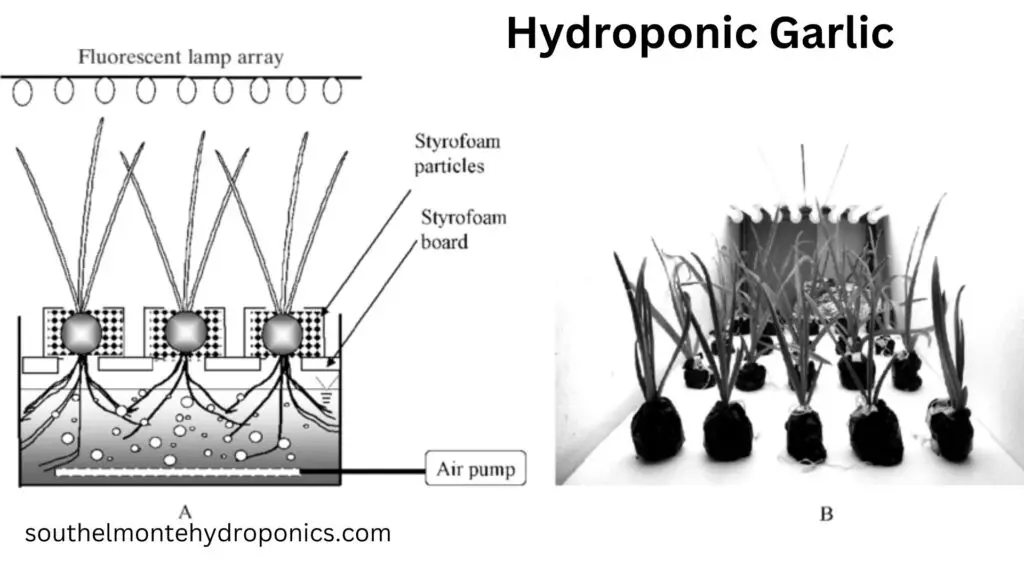
Germinating garlic seeds and establishing strong seedlings is a crucial step in starting a successful hydroponic garlic system. To begin, carefully select the garlic seeds you plan to use for your hydroponic cultivation. It’s important to choose high-quality seeds from a reputable source to ensure the best chances of success.
Before sowing the seeds, it’s recommended to soak them in water for about 24 hours. This helps to soften the outer seed coat and promote germination. After soaking, you can place the seeds in a damp paper towel inside a sealed plastic bag to create a moist environment. Keep the bag in a warm location, ideally around 70°F (21°C), to encourage germination.
Within a week, you should start to see small green shoots emerging from the seeds. Once the shoots reach a height of 2-3 inches (5-7.5 cm), carefully transplant them into a growing medium specifically designed for hydroponic systems. This medium should provide excellent water retention while allowing for proper aeration of the roots. Gently place each seedling into the growing medium, ensuring that the roots are well-distributed and covered. Properly established seedlings will serve as the foundation for a healthy and productive hydroponic garlic crop.
Below is a table summarizing key aspects of hydroponic garlic cultivation:
| Aspect | Description |
|---|---|
| Growing Medium | Typically, hydroponic garlic is cultivated without soil. Common growing mediums include coconut coir, perlite, vermiculite, or a combination of these. |
| Nutrient Solution | A carefully balanced nutrient solution is used to provide essential elements for garlic growth. The solution is circulated in a closed system, minimizing waste. |
| Water Usage | Hydroponic systems are known for water efficiency. They use less water compared to traditional soil-based farming due to recirculation and controlled irrigation. |
| Temperature Control | The controlled environment of hydroponic systems allows for precise temperature regulation, promoting optimal garlic growth throughout the year. |
| pH Control | Maintaining a specific pH range (usually around 6.0 to 6.5) is crucial for nutrient absorption. Hydroponic systems enable easy adjustment of pH levels as needed. |
| Yield and Growth Rate | Hydroponic garlic tends to exhibit faster growth rates and higher yields compared to traditional soil cultivation, providing more efficient crop production. |
| Space Utilization | Hydroponic systems can be designed vertically or in compact setups, maximizing space utilization. This is particularly beneficial for urban or limited-space farming. |
| Disease Resistance | Hydroponic garlic cultivation reduces the risk of soil-borne diseases, as plants are not in direct contact with the ground. This enhances overall disease resistance. |
| Automation Potential | Hydroponic systems can be easily automated, allowing for the monitoring and control of various parameters, reducing labor requirements and ensuring consistent growth. |
| Environmental Impact | With reduced need for pesticides and minimal soil erosion, hydroponic garlic cultivation can have a lower environmental impact compared to traditional farming methods. |
| Seasonal Independence | Hydroponic systems enable year-round garlic production, overcoming seasonal limitations and providing a consistent supply to meet market demand. |
This table highlights the key features and advantages associated with hydroponic garlic cultivation.
Transplanting Garlic Seedlings into the Hydroponic System: Guidance on when and how to successfully transfer young garlic plants into the hydroponic system without causing any damage.
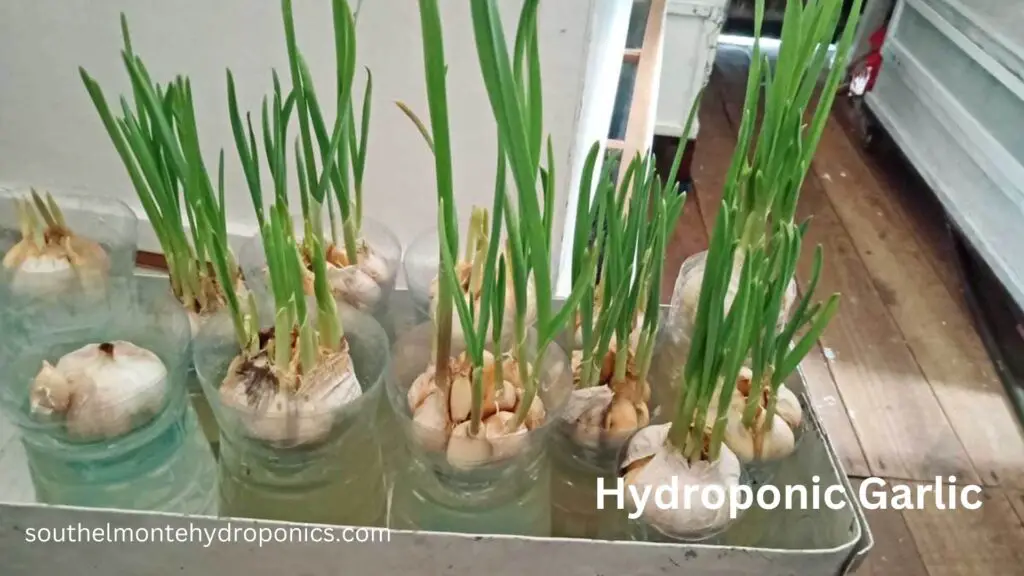
Transplanting garlic seedlings into the hydroponic system is a critical step in ensuring their successful growth and development. Timing is crucial when it comes to transferring young garlic plants, as they need to have strong roots and a healthy leaf structure before being transplanted. Generally, garlic seedlings are ready to be transplanted when they have developed at least four to six leaves and their roots are well-established.
To start, prepare the hydroponic system by ensuring that all the necessary components are in place and the nutrient solution is properly balanced. Carefully remove the garlic seedlings from their current growing medium, shaking off any excess soil or debris. Be gentle during this process to avoid damaging the delicate roots. Then, using your fingers or a small tool, create a hole in the hydroponic medium that is slightly larger than the root ball of the seedling.
Next, carefully place the garlic seedling into the hole, ensuring that the roots are spread out and not bunched up. Gently press the hydroponic medium around the seedling to provide stability and support. Take care not to compact the medium too tightly, as this could impede the seedling’s access to oxygen and water. Once all the seedlings have been transplanted, adjust the lighting and nutrient solution according to the specific needs of garlic plants in the hydroponic system.
By following these guidelines for transplanting garlic seedlings into the hydroponic system, you can minimize stress and damage to the young plants, allowing them to thrive in their new environment. With proper care and attention throughout the growth cycle, you will soon enjoy a bountiful harvest of flavorful and nutritious hydroponically-grown garlic.
Maintaining Optimal Growing Conditions for Hydroponic Garlic: Detailed information on providing the right temperature, light, and humidity levels to ensure healthy growth and maximize
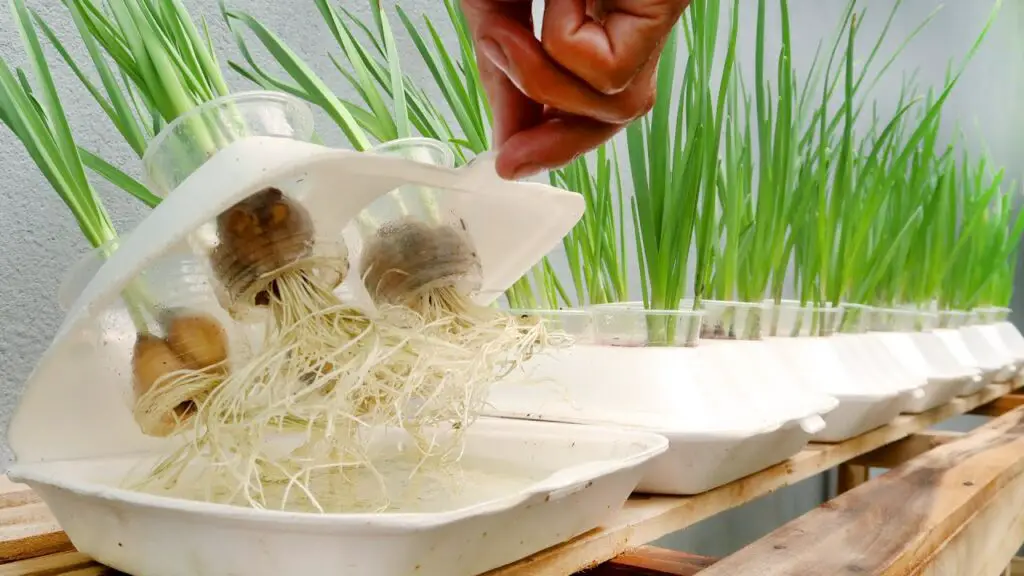
Maintaining optimal growing conditions is crucial for hydroponic garlic production, as it directly affects the health and productivity of the plants. To ensure healthy growth and maximize yields, it is essential to provide the right temperature, light, and humidity levels.
Temperature plays a crucial role in hydroponic garlic cultivation. The ideal temperature for garlic growth ranges between 60 and 77 degrees Fahrenheit. Maintaining a consistent temperature within this range helps promote healthy root development and enhances overall plant growth. Fluctuations in temperature can lead to stress and hinder the growth process. It is recommended to use a thermometer to monitor the temperature inside the hydroponic system regularly. Additionally, using appropriate heating or cooling systems is essential to maintain a stable environment for optimal garlic growth.
Light is another critical factor in maintaining optimal growing conditions for hydroponic garlic. Garlic plants require around 12 to 16 hours of light per day for optimum growth. Using grow lights with specific spectrums, such as LEDs or high-intensity discharge (HID) lamps, can provide the necessary light intensity and spectrum for the plants. Positioning the lights at an appropriate distance above the plants and ensuring even distribution of light across the entire growing area is crucial. Regular monitoring of light intensity and adjusting the light source height accordingly will help ensure that the plants receive the right amount of light for photosynthesis.
In addition to temperature and light, humidity levels also play a vital role in hydroponic garlic cultivation. Garlic plants thrive in environments with moderate humidity levels, ideally ranging from 40% to 65%. High humidity can create a favorable environment for fungus and disease development, while low humidity can cause the plants to dry out. To maintain optimal humidity levels, proper ventilation and airflow within the growing area are essential. Using fans or ventilation systems can help circulate the air and prevent excessive moisture buildup. Regular monitoring of humidity levels and adjustments to the growing environment will promote healthy garlic growth and minimize the risk of fungal diseases.
By carefully monitoring and maintaining the right temperature, light, and humidity levels, hydroponic garlic growers can create an optimal growing environment for their plants. These key factors contribute to healthy growth, robust root development, and ultimately maximize yields. In the next section, we will explore the role of nutrients and water in hydroponic garlic cultivation and how to ensure a nutrient-rich solution for sustained plant growth.
Hydroponic garlic cultivation offers several benefits compared to traditional soil-based methods. Here are some advantages:
- Faster Growth: Hydroponic systems provide a controlled environment with optimal conditions for plant growth. Garlic tends to grow faster in hydroponic setups, allowing for quicker harvest cycles.
- Higher Yields: With precise control over nutrient levels and environmental factors, hydroponics can result in higher garlic yields per square foot compared to traditional soil cultivation. This can be particularly beneficial for commercial growers.
- Water Efficiency: Hydroponic systems use less water than traditional soil farming because they recirculate water within the closed system. This is especially advantageous in regions facing water scarcity or where water conservation is a priority.
- Space Utilization: Hydroponic systems can be designed in vertical or compact setups, maximizing the use of limited space. This is especially useful in urban farming or areas with limited arable land.
- Reduced Environmental Impact: Hydroponic systems typically require fewer pesticides and herbicides compared to traditional farming. Additionally, the controlled environment minimizes the risk of soil erosion and nutrient runoff, contributing to overall environmental sustainability.
- Year-Round Production: Hydroponic garlic cultivation allows for year-round production since environmental conditions can be controlled, eliminating the dependence on seasonal changes. This can be a significant advantage in meeting market demand consistently.
- Nutrient Control: In hydroponics, growers have precise control over nutrient levels, ensuring that garlic plants receive the essential elements they need for optimal growth. This can lead to healthier plants and better-quality garlic bulbs.
- Reduced Disease Risk: Hydroponic systems can reduce the risk of soil-borne diseases that often affect garlic in traditional cultivation. The absence of soil eliminates the transmission of certain pathogens, leading to healthier plants.
- Space Flexibility: Hydroponic systems can be set up in various locations, including urban areas or areas with poor soil quality. This flexibility allows garlic cultivation in regions where traditional farming may not be feasible.
- Automation Potential: Hydroponic systems can be easily automated, enabling growers to monitor and control various parameters such as nutrient levels, pH, and temperature. This not only reduces labor costs but also ensures consistent and optimal growing conditions.
- Quality Control: The controlled environment of hydroponics allows for better quality control. Garlic produced in hydroponic systems may have consistent size, flavor, and appearance, meeting specific market preferences.
Overall, hydroponic garlic cultivation offers a sustainable and efficient alternative to traditional soil-based methods, addressing various challenges faced by modern agriculture.
What is the ideal temperature for growing hydroponic garlic?
The ideal temperature for growing hydroponic garlic is between 60-75 degrees Fahrenheit (15-24 degrees Celsius).
How much light does hydroponic garlic require?
Hydroponic garlic requires about 12-16 hours of light per day.
Can I use artificial light for hydroponic garlic?
Yes, you can use artificial light such as LED or fluorescent lights to provide the necessary light for hydroponic garlic growth.
What is the recommended humidity level for hydroponic garlic?
The recommended humidity level for hydroponic garlic is around 50-70%.
How often should I change the water solution for hydroponic garlic?
It is recommended to change the water solution for hydroponic garlic every 1-2 weeks to ensure a fresh and nutrient-rich environment.
Can I grow different varieties of garlic hydroponically?
Yes, you can grow different varieties of garlic hydroponically. However, it is important to choose varieties that are suited for hydroponic cultivation.
How long does it take for garlic seeds to germinate in hydroponics?
Garlic seeds typically take about 7-10 days to germinate in hydroponics.
When should I transplant the garlic seedlings into the hydroponic system?
Garlic seedlings should be transplanted into the hydroponic system once they have developed strong roots and are about 4-6 inches tall.
What can I do to prevent pests and diseases in hydroponic garlic?
To prevent pests and diseases in hydroponic garlic, it is important to maintain a clean growing environment, regularly check for signs of pests or diseases, and implement appropriate pest control measures if necessary.
How long does it take for hydroponic garlic to reach maturity?
Hydroponic garlic typically takes about 90-120 days to reach maturity, depending on the variety and growing conditions.

